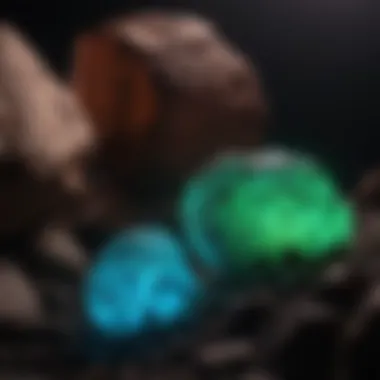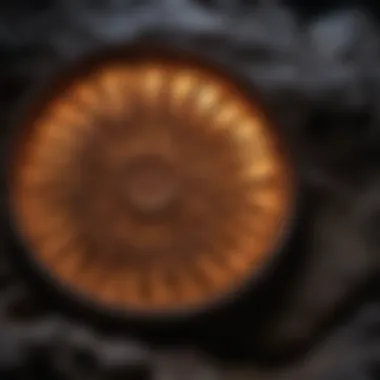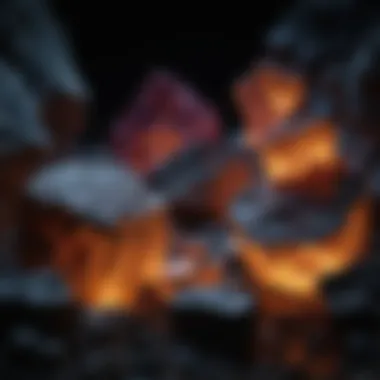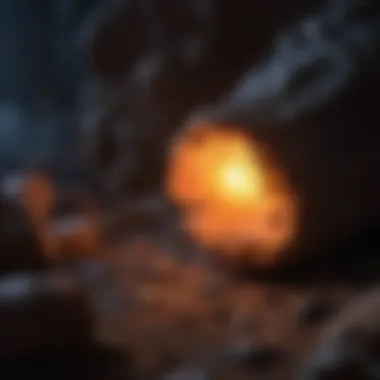Unveiling the Enigmatic World of Black Light Flashlights in Geological Exploration


Geological Insights
Delving into the geological realm unravels a tapestry of ancient processes and earth-shaping events that have sculpted the landscape we behold today. Understanding the formation of geological structures like mountains, valleys, and caves provides insight into the earth's dynamic evolution over eons. Exploring the historical significance of rocks and fossils unveils intriguing narratives of prehistoric life forms and climatic conditions that have shaped our planet's history. Notable discoveries in the field continue to expand our knowledge of the earth's geology, unveiling new chapters in the ever-unfolding story of our planet.
Introduction
In the realm of rock and fossil collection, the utilization of powerful black light flashlights introduces a fascinating dimension that enhances the exploration experience. The play of black light technology in revealing hidden fluorescent patterns and distinguishing unique geological specimens unveils a world of discovery for collectors and enthusiasts alike. As we delve into the exploration of black light flashlights in this article, we embark on a journey to uncover the mesmerizing allure and potent capabilities of this transformative technology.
Black light flashlights serve as potent tools for rock and fossil collectors, offering insight beyond the surface appearance of specimens. By emitting ultraviolet light, these specialized flashlights unveil fluorescence patterns that are not visible under standard lighting conditions. This ability to reveal hidden features opens up a treasure trove of secrets within rocks, minerals, and fossils, elevating the collector's ability to identify and appreciate the intricate details that lie beneath the surface.
Beyond mere identification, the application of black light technology delves deeper into the geological composition, enabling enthusiasts to detect intricate fossil patterns that might go unnoticed in conventional settings. Through the illumination provided by black light flashlights, collectors can discern fine details, textures, and structures within fossils, enhancing their understanding and appreciation of these ancient remnants. This aspect of the technology adds a layer of sophistication to the collection process, turning each discovery into a journey of scientific inquiry and discovery.
Moreover, the differentiation of geological features is significantly enhanced through the use of black light flashlights. By showcasing unique fluorescence responses in various minerals and rocks, collectors gain valuable insights into the geological composition and history encapsulated within each specimen. The distinct patterns and colors revealed under black light illumination can provide clues about the mineralogy, age, and formation processes of rocks and fossils, offering a broader perspective on the earth's geological past.
As we navigate through the intricacies of black light technology in rock and fossil collection, we unravel a tapestry of vibrant fluorescence and intricate details, enriching the experience of collectors and geology enthusiasts. Through the exploration of black light flashlights, we open doors to a realm of discovery and scientific inquiry that transcends the ordinary, inviting individuals to delve deeper into the mysteries of the earth's ancient past.
Understanding Black Light Technology
Black light technology plays a pivotal role in revolutionizing rock and fossil collection, offering collectors a new perspective on their specimens. Understanding black light technology is essential in maximizing the potential of this tool in geological exploration. By harnessing the power of black light, collectors can unveil hidden fluorescent patterns, differentiate between various geological features, and detect fossil patterns that may be invisible to the naked eye. This section will delve into the significance of comprehending black light technology, exploring its specific elements, benefits, and considerations in the context of rock and fossil collection.
What is Black Light?
Black light, also known as ultraviolet light, is a type of light characterized by its ability to cause certain materials to fluoresce. This unique characteristic allows collectors to identify minerals, fossils, and geological features that exhibit fluorescence under black light. Understanding the properties of black light is crucial in rock and fossil collection as it facilitates the detection of hidden patterns and structures that are not visible in normal light conditions.


Principles of Fluorescence
The principles of fluorescence underpin the phenomenon observed when materials emit visible light after being exposed to black light. This property is utilized in rock and fossil collection to distinguish between different types of minerals and fossils based on their fluorescence patterns. Knowledge of fluorescence principles enables collectors to make informed decisions regarding specimen identification and classification, enhancing the accuracy and efficiency of their exploration.
Types of Black Light Flashlights
There are various types of black light flashlights available, each designed for specific purposes in geological exploration. From long-wave ultraviolet flashlights to short-wave ultraviolet models, collectors can choose the most suitable option based on the materials they are examining. Understanding the characteristics and differences of these black light flashlights is essential for collectors to optimize their viewing experience and extract valuable information from their rock and fossil specimens.
Application in Rock and Fossil Collection
In this section, we will delve into the vital role that black light technology plays in the field of rock and fossil collection. The application of black light flashlights introduces a revolutionary approach to geological exploration, allowing enthusiasts to uncover hidden fluorescent patterns, identify unique geological specimens, and differentiate various geological features with precision and ease. By harnessing the power of black light, collectors are presented with a new dimension of discovery and observation, enhancing the overall experience of exploring the intricacies of rocks and fossils.
Revealing Fluorescent Minerals
One of the primary advantages of utilizing black light flashlights in rock and fossil collection is the ability to reveal fluorescent minerals. These minerals, under normal light conditions, may appear indistinguishable from non-fluorescent rocks. However, when exposed to ultraviolet light emitted by black light flashlights, these minerals exhibit extraordinary fluorescence, emitting visible light of different colors. This phenomenon enables collectors to easily identify and distinguish fluorescent minerals from non-fluorescent ones, adding a fascinating element to their exploration and analysis.
Detecting Fossil Patterns
Another significant aspect of black light technology in rock and fossil collection is its proficiency in detecting fossil patterns. Fossils often exhibit intricate patterns and details that may be challenging to discern with the naked eye. By using black light flashlights, collectors are able to illuminate fossils and uncover hidden patterns that may not be readily visible in standard lighting conditions. This method not only enhances the visibility of fossil details but also aids in the accurate identification and analysis of fossil specimens, providing enthusiasts with a unique perspective on prehistoric life forms.
Differentiating Geological Features
Black light technology also proves invaluable in differentiating geological features during collection expeditions. Certain rocks and minerals possess distinct fluorescence properties that can vary based on their composition and structure. By employing black light flashlights, collectors can classify and categorize geological specimens more effectively by observing the unique fluorescence patterns exhibited. This aids in the accurate identification of rock types, mineral variations, and geological formations, allowing enthusiasts to develop a deeper understanding of the geological characteristics present in their collection.


Best Practices for Using Black Light Flashlights
When delving into the captivating world of rock and fossil collection, understanding the best practices for using black light flashlights is paramount. In this section, we will unravel the essential elements that make using these flashlights a transformative experience. By following specific guidelines and techniques, collectors and enthusiasts can unlock a trove of hidden phenomena that conventional lighting fails to reveal. The primary focus will be on maximizing the efficiency and effectiveness of black light flashlights, ensuring that every exploration yields insightful discoveries and enriching experiences.
Optimal Conditions for Viewing
To fully harness the power of black light technology in rock and fossil collection, it is crucial to create optimal viewing conditions. This includes controlling ambient light, adjusting the distance and angle of the flashlight, and considering the wavelength of the light emitted. By optimizing these variables, collectors can enhance the visibility of fluorescent minerals and fossil patterns, bringing out their mesmerizing details under the black light's glow. Achieving the ideal viewing conditions not only amplifies the beauty of the specimens but also aids in accurate identification and appreciation of their geological significance.
Avoiding Contaminants
When utilizing black light flashlights in rock and fossil collection, avoiding contaminants is pivotal to maintaining the integrity of the specimens. Contaminants such as dust, oils, or residues can interfere with the fluorescence effect, hampering the ability to observe intricate patterns and details. Strategies for avoiding contaminants may involve proper cleaning of specimens, using clean tools and equipment, and ensuring a dust-free environment during examination. By diligently following these practices, collectors can preserve the authenticity and clarity of their geological finds, prolonging their beauty for future study and enjoyment.
Preservation Techniques
Preserving rock and fossil specimens is essential for their longevity and protection against degradation. In this section, we will explore the best preservation techniques for maintaining the quality and structure of collected items. From safeguarding fragile fossils to preventing mineral discoloration, implementing effective preservation methods is key to conserving the integrity of geological treasures. Topics to be covered include storage practices, handling guidelines, and environmental factors to consider for optimal preservation. By adhering to proven preservation techniques, collectors can ensure that their precious finds remain pristine and valuable for generations to come.
Enhancing the Collection Experience
In the realm of rock and fossil collection, enhancing the collection experience holds paramount importance. This section delves into how maximizing the potential of black light flashlights can elevate collectors' interactions with their specimens, providing a deeper understanding of their geological significance, composition, and uniqueness. By shedding light on hidden fluorescent patterns and mineral compositions, collectors can unlock a new level of exploration and appreciation for their collections.
Creating Spectacular Displays
Creating spectacular displays goes beyond merely showcasing rocks and fossils. It involves curated presentations that highlight the fluorescence and intricacies of each specimen when illuminated by black light. Whether setting up exhibits for personal enjoyment or educational purposes, the arrangement of specimens under black light can create stunning visual effects, accentuating the beauty and diversity of geological treasures.


Educational Outreach
Engaging in educational outreach amplifies the impact of rock and fossil collections. By incorporating black light technology into educational initiatives, enthusiasts can inspire curiosity and foster learning about geology, fluorescence, and the natural world. Sharing the unique qualities revealed by black light enhances the educational value of collections, making them interactive and engaging for students, researchers, and amateur enthusiasts alike.
Community Engagement
Community engagement forms a vital aspect of rock and fossil collection. Utilizing black light flashlights to showcase fluorescent minerals and fossils can ignite interest within local communities, museums, and scientific institutions. Organizing events, workshops, or exhibitions that feature the captivating effects of black light on geological specimens not only educates but also fosters a sense of shared exploration and appreciation for the wonders of the earth's history.
Future Trends in Black Light Application
In the expansive field of rock and fossil collection, the concept of Future Trends in Black Light Application holds a pivotal role in driving innovation and enhancing exploration methodologies. As technology continues to evolve at a rapid pace, embracing advancements in how black light flashlights are used can significantly revolutionize the way collectors interact with their specimens. Keen attention to these emerging trends provides collectors with a competitive edge by facilitating the identification of fluorescent minerals and fossil patterns with greater precision and efficiency. Exploring the future trends in black light application allows enthusiasts to stay at the forefront of technological developments, ensuring a more enriching and immersive experience in geological exploration.
Advancements in Technology
The realm of black light technology is constantly witnessing groundbreaking Advancements in Technology, leading to improved functionality and performance of black light flashlights. These technological strides aim to enhance the intensity and wavelength range of emitted UV light, enabling collectors to uncover hidden fluorescent properties in minerals and fossils with unparalleled clarity. Moreover, advancements such as more compact and portable designs and longer battery life contribute to the convenience and sustainability of utilizing black light technology in the field. By incorporating these advancements into their collection practices, enthusiasts can achieve higher levels of accuracy and efficiency in identifying and examining geological specimens, propelling their exploration endeavors to new heights.
Exploration of New Territories
One of the most compelling aspects of Future Trends in Black Light Application is the Exploration of New Territories, both literally and figuratively. Geologists and collectors are continually venturing into uncharted domains, leveraging black light technology to delve deeper into geological landscapes that were previously inaccessible or overlooked. By illuminating remote locations with black light flashlights, researchers can uncover fluorescent minerals and fossil imprints that may have remained concealed from traditional exploration methods. This exploration of untouched territories not only expands the boundaries of geological knowledge but also opens up novel possibilities for discovery and analysis, enriching the overall narrative of rock and fossil collection.
Research and Development
The synergy between Research and Development and black light technology paves the way for continuous innovation and experimentation in the field of rock and fossil collection. As scientists and engineers collaborate to refine existing technologies and introduce novel applications of black light flashlights, collectors stand to benefit from enhanced tools and methodologies for geological exploration. Research initiatives focusing on spectroscopy, mineral identification algorithms, and UV light optimization play a crucial role in advancing the capabilities of black light technology, enabling enthusiasts to unlock new facets of geological specimens that were previously inaccessible. By staying abreast of the latest Research and Development efforts in the field, collectors can stay ahead of the curve and fully harness the potential of black light technology to enrich their collection experiences.
Conclusion
In the realm of rock and fossil collection, the compelling utilization of black light flashlights marks a significant leap in enhancing geological exploration capabilities. Throughout this article, we have delved deep into the transformative potential of harnessing black light technology to unveil hidden fluorescent patterns, identify unique geological specimens, and elevate the collection experience for enthusiasts. It is crucial to acknowledge the importance of the conclusion section as it serves as the culmination of our exploration into the power of black light flashlights, summarizing key insights and findings for our readers.
The conclusion encapsulates the essence of how black light flashlights can revolutionize traditional collection methodologies by shedding light on unseen fluorescent minerals, fossil patterns, and geological features. By integrating optimal viewing conditions, avoiding contaminants, and implementing preservation techniques, collectors are empowered to elevate their discoveries to new heights and preserve them effectively. The significance of this final section lies in its ability to synthesize the information presented throughout the article, providing a comprehensive guide for rock and fossil collectors to harness the full potential of black light technology.
Furthermore, the conclusion section emphasizes the broader implications of embracing black light technology in the geological exploration domain. As advancements in technology continue to drive innovation, exploring new territories and pushing the boundaries of research and development, black light flashlights emerge as indispensable tools for both seasoned collectors and budding enthusiasts. By fostering a deeper understanding of geological specimens and engaging in educational outreach and community involvement, collectors can share their discoveries and inspire further interest in the fascinating world of rock and fossil collection. In essence, the conclusion not only recaps the key points discussed but also prompts readers to embark on their journey of discovery armed with the knowledge and insights gained from this exploration of black light technology.







